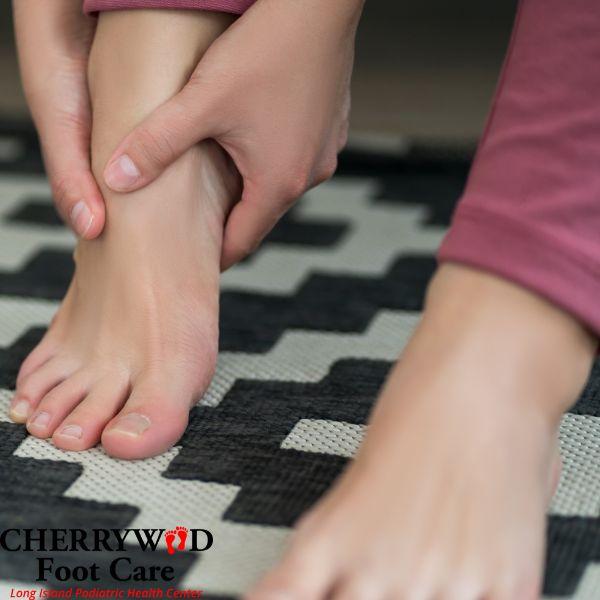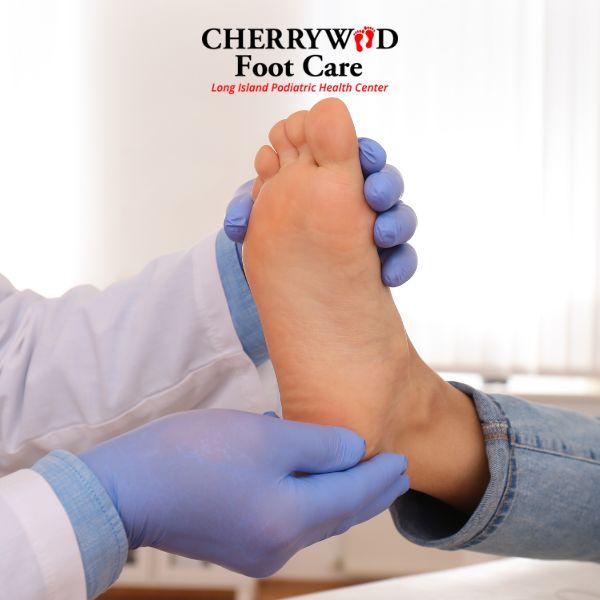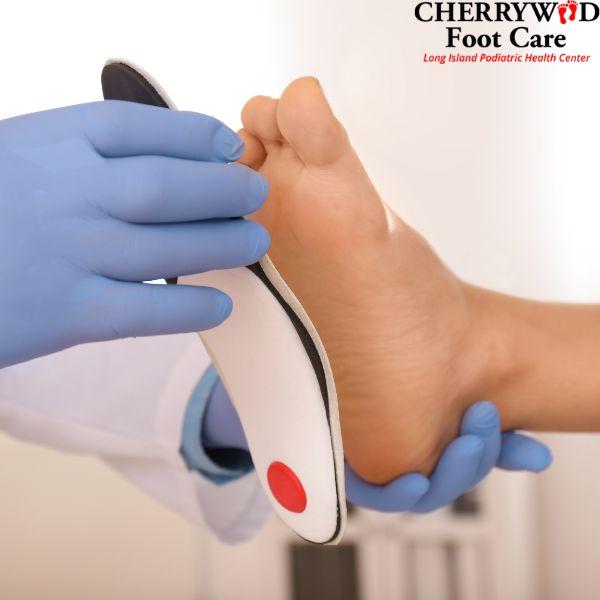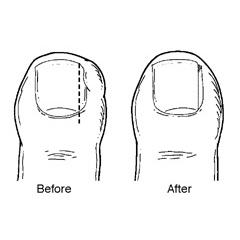Best Podiatrist Near Me 11710
The Best Podiatrist Near Me 11710 At Cherrywood Foot Care
Did you know toenail fungus is referred to as Onychomycosis? Onychomycosis is when the nail plate looks thickened and is yellow or cloudy and can be treated by the best podiatrist near me 11710. In some cases, the nail can become rough and crumbled and can separate from the nail bed. Most individuals do not feel pain when they have toenail fungus unless the disease is severe. If you feel like you may have Onychomycosis and are looking for the best podiatrist near me 11710, contact Cherrywood Foot Care today and schedule your appointment!
Different Types of Fungal Nail Infections
Fungi are tiny organisms that can only be seen through a microscope. They can live on your skin and not cause any harm to you. But if you happen to have several in one area, it can get infected. The four different types include:
- Distal or lateral subungual Onychomycosis– This is the most common kind, and you can get it in your fingernails or toenails. It starts in the nail bed, underneath the nail, and looks yellow.
- White superficial Onychomycosis– This kind is mainly on your toenails. It first starts as white spots, then becomes powdery and causes the nail to crumble.
- Proximal subungual Onychomycosis– This first appears as white spots in the center of the nail bed. It moves outward as the finger or toenail grows. This kind is rare and usually affects people who have suffered from immune system conditions.
- Candidal Onychomycosis– This is when the area around the nails is swollen and inflamed, and it completely comes off. It usually happens to nails damaged before an injury or another infection.
Symptoms of Toenail Fungus
- You notice a white or yellow spot under your nail; over time, it spreads to your whole nail and turns white, yellow, green, or black.
- The nail thickens and is hard to trim.
- It starts to curl up or down and loosens from the nail bed.
- Your nail becomes brittle and crumbles when you touch it.
- Your nail becomes misshapen.
- You notice a bad smell.
Treatment: Best Podiatrist Near Me 11710
At Cherrywood Foot Care, we use lasers to treat your toenail fungus. Our laser is a patented device that utilizes near-infrared light. The laser passes through the toenail without causing any damage to the patient’s nails or skin. The laser then applies a cool cryogen spray when the laser reaches its optimum temperature. Many other lasers do not have the same ability as this device and do not provide the same results.
Most patients only need 2-3 laser treatments to get back to health. This is a safe treatment that is not painful at all.
Contact Us: Best Podiatrist Near Me 11710
Toenail fungus is ugly and uncomfortable. Don’t allow this to stop you from your daily life. If you feel like you may have Onychomycosis and are looking for the best podiatrist near me 11710, contact Cherrywood Foot Care, today and schedule your appointment!
Contact The Best Podiatrist Near Me 11710
Ankle Sprains occur when there is an injury to the ligaments of the ankle. An ankle sprain can leave you in pain and can interfere with your everyday life. If you are experiencing an ankle sprain or similar injury, our expert ankle pain treatment on Long Island at Cherrywood Foot Care, the best podiatrist near me 11710, can help!
What Causes a Sprained Ankle?
 Ankle sprains can happen to anyone, regardless of how active they are, and at any age. They can be caused by twists and rolls that move the joint out of its normal position, typically in an awkward way. These twists or rolls then cause the ligament to excessively stretch or tear, causing a sprain. Ankle sprains can happen due to:
Ankle sprains can happen to anyone, regardless of how active they are, and at any age. They can be caused by twists and rolls that move the joint out of its normal position, typically in an awkward way. These twists or rolls then cause the ligament to excessively stretch or tear, causing a sprain. Ankle sprains can happen due to:
- A bad fall
- Landing awkwardly on your ankle after jumping
- Walking on an uneven surface
- Wearing inappropriate footwear
- Another person landing on your foot during physical activity
- Not stretching properly before physical activity, or having a low level of flexibility in the ankle
Symptoms of a Sprained Ankle
If you are experiencing ankle pain after an incident like this, it is important to speak to a doctor to figure out the severity of the injury and receive ankle pain treatment on Long Island. However, there are signs and symptoms you can look for to determine the likelihood of your injury being an ankle sprain. Some of these symptoms include:
- Swelling
- Bruising
- Tenderness
- Pain following the injury
- Skin discoloration
- Stiffness
- Inability to put weight on the affected ankle
- Restricted range of motion
- Instability in the ankle
The symptoms experienced all depend on the severity of the injury. Some sprains are worse than others and if they are left untreated, they can lead to long-term pain and instability in the ankle. It is very important to understand both the treatment options for a sprained ankle and ways to prevent it in the future!
Ways to Prevent an Ankle Sprain
While you cannot completely protect yourself from ankle sprains and accidents do happen, it is always a good idea to look at ways to lower the risk of obtaining these injuries. To lower your risk for future sprains, you can:
- Wear well-fitted shoes
- Warm-up before exercising
- Pay attention to the surfaces you are walking on
- Maintain strength, balance, and flexibility when exercising
Ankle Pain Treatment on Long Island
If these preventative measures fail and you sustain an ankle injury, it is important to seek medical attention before the condition worsens. If you have experienced an injury similar to this and are looking for the best podiatrist near me 11710, Cherrywood Foot Care is here to help! Cherrywood Foot Care offers X-Ray services, orthotics, surgical procedures, therapies, and more to help you heal as quickly as possible! Contact us today and visit our website to see how we can help you get back on your feet!
Are you in need of the best podiatrist near me 11710? As the summer sun continues to shine down on us, it is important to take care of your feet. Diabetics need to protect their feet at all times. The side effects of the feet of someone living with diabetes can be painful and need to be treated. If you are looking for the best podiatrist near me 11710, Cherrywood Foot Care is the place for you!
What is Diabetes?
Diabetes affects the body’s ability to produce insulin. It interferes with controlling the body’s blood sugar. Cells resist the body’s natural insulin making the glucose remain in the blood instead of being taken to the cells. This can lead to a decrease in energy and elevated blood sugar levels. Here are the types of diabetes:
- Type 1- It is an autoimmune disease that affects the pancreas. The body attacks natural insulin. Insulin injections need to be taken to maintain blood sugar levels.
- Type 2- It is a chronic disease where the body is unable to maintain blood sugar levels making them extremely high and dangerous. About 95% of diabetes cases are type 2.
Click here to learn more about diabetes.
How Does Diabetes Impact Feet?
 There are multiple ways that diabetes affects one’s feet. Proper foot care is important to prevent future problems or conditions. Bad foot health can lead to more serious measures such as amputation. Wearing shoes that fit properly and keeping your feet covered is a major factor for foot health. Here are some ways that diabetes affects the feet:
There are multiple ways that diabetes affects one’s feet. Proper foot care is important to prevent future problems or conditions. Bad foot health can lead to more serious measures such as amputation. Wearing shoes that fit properly and keeping your feet covered is a major factor for foot health. Here are some ways that diabetes affects the feet:
- Dry Skin
- Skin Discoloration and Itching
- Thickening of the Toenails
- Sharp Pains of the Toes
- Cramping of the legs and feet
- Bunions, Hammertoes, Ingrown Toenails
- Ankle Pain
To learn more about diabetic foot health click here.
How Can The Best Podiatrist Near Me 11710 Help?
Our well-trained doctors will examine the foot to find how diabetic foot health is affecting you. Looking at the skin, toenails, blood circulation, movement, footwear, and deformities will allow our doctors to find the right treatment for you. Here are possible treatment options:
- Antibacterial Foot Cream
- Keeping Feet Covered
- Keep Feet Away from the Sun
- Change Your Diet
- Exercise to Increase Blood Flow
Contact Cherrywood Foot Care – Local Podiatrist Near Bethpage NY!
If you are struggling with diabetic foot health management, the best podiatrist near me 11710 wants to help you. We want to find solutions that are specific to your needs. Let us help you get back to a safe and comfortable life. Contact us today!
A heel spur can be a very aggravating condition and may ruin one’s quality of life, so make sure you see the best podiatrist near me 11710 at our Bellmore office. The persistent, stabbing pain of a heel spur may interfere with exercise or work-related tasks. Addressing this condition as early as possible is important and can be life-changing. If you think you’re suffering from a heel spur and are looking for podiatrist Bethpage NY, contact us today and schedule your appointment at our Bellmore office!
What is a heel spur?
 Also known as a calcaneal spur, heel spurs are a process where calcium deposits build up on the underside of the heel bone over the course of many months. They are caused by overexertion or strain of the foot muscles and stretching of ligaments, resulting in repeated tears of the plantar fascia, which is a ligament that runs along the underside of the foot. It is most common among athletes or those who endure great amounts of physical activity like running and jumping, so make sure to check in with the best podiatrist near me 11710 today in Bellmore.
Also known as a calcaneal spur, heel spurs are a process where calcium deposits build up on the underside of the heel bone over the course of many months. They are caused by overexertion or strain of the foot muscles and stretching of ligaments, resulting in repeated tears of the plantar fascia, which is a ligament that runs along the underside of the foot. It is most common among athletes or those who endure great amounts of physical activity like running and jumping, so make sure to check in with the best podiatrist near me 11710 today in Bellmore.
Risk Factors
Poorly worn shoes – Shoes that lack decent arch support can cause heel spurs.
Excess weight – Too much weight on your feet can trigger heel spurs due to stress.
Walking abnormalities – Puts excessive stress on the heel bone, nerves, and ligaments.
Running or jogging – Improper running equipment or running on hard surfaces may trigger the condition.
Other factors – Age, underlying health conditions, or spending most days on your feet may also cause heel spurs.
Symptoms
- Chronic pain while walking or jogging
- Inflammation
- Stabbing pain in the heel
- Sharp pain that turns into a dull ache throughout the day
- May show no symptoms
Treatment: Best Podiatrist Near Me 11710
Rest is not an ideal treatment for heel spurs, as the plantar fascia suddenly elongates after a long night’s sleep. To remedy this condition, it is important to have proper shoewear that supports the arch of the foot or orthotic devices that you can insert into your shoe. Stretching exercises, taping or strapping to rest tendons, or physical therapy are great treatments, as well as over-the-counter medication to decrease pain and inflammation.
More than 90 percent of people get better with these treatments. In the worst-case scenario, when heel spurs reach a period of nine to twelve months of persistence, surgery may be necessary to cure heel spurs.
Heel spurs can happen to anyone and may ruin one’s quality of life. Addressing this condition as early as possible is very important and can be life-changing. If you are experiencing symptoms of this condition and are looking for the best podiatrist near me 11710, please contact us today and book your appointment at our Bellmore office!
Causes

Plantar fasciitis is caused by putting a strain on the ligament and causing small tears. This can cause extreme heel pain, and ignoring it can cause the pain to become worse and possibly permanent. Plantar fasciitis can usually be self-diagnosed. the following risk factors can increase your risk of developing this condition:
- Age – plantar fasciitis is most common between the ages of 40 to 60
- Temperature Treatment – icing your plantar fascia can reduce the inflammation causing the pain in your heel
- Obesity – excessive weight can put too much strain on your plantar fascia
- Foot Mechanics – flat feet, abnormal arch, or a bad walking pattern can contribute to the development of plantar fasciitis
Remedies For Plantar Fasciitis
There are several ways to heal plantar fasciitis. Below are some common treatments from the best podiatrist near me 11710:
- Night Splints – this is a device worn to stretch your calf and foot
- Rest – if an activity causes pain, do that activity less or not at all to give your plantar fascia time to heal
- NSAI – taking a pain reliever such as Ibuprofen can relieve the pain and make day to day activities easier
- Shoe Sole Inserts – shoe inserts can be fitted to your specific foot shape and arch, supporting your foot and relieving the pain caused by stress on the ligaments in your feet
Treatment For Best Podiatrist Near Me 11710
Cherrywood Foot Care is a doctor’s office that can treat you. We are specialized in foot care and can develop a treatment to help fix your plantar fascia. We will implement one or more of the above treatments and monitor your condition to ensure that the treatments we are using are working.
If you are looking for the best podiatrist near me 11710, our team at Cherrywood Foot Care can help you! Contact us today to learn more about foot sprains and how we can diagnose and treat them.
Ways to Sprain Your Foot:
- Twisting
- Landing wrong
- Walking on an uneven surface
- Someone stepping or landing on your foot
These are all ways that you could sprain your ankle but not all of them. Click here to learn more.
How to Prevent a Sprained Foot
When you are super tired or in pain, make sure to stop the activity. This will cause an injury because when you get tired, your muscles relax and do something wrong that will injure you. Ensure to eat a healthy diet to keep your muscles strong. Wear shoes that fit well. There are many incidents where injuries happen from the wrong shoe size. It is easy to trip when your shoe is too big or to squeeze your feet when too small. Just be mindful that that is what could be causing your injuries. The best podiatrist near me 11710 will be able to assist you with these issues.
How Do I Know if I Sprained My Foot?
There are many ways that you would know if you have sprained your foot. Here are some examples, and if these apply to you, make sure that you visit the best podiatrist near me 11710, Cherrywood Foot Care.
- Pain in the arch of your foot
- Pain while walking
- Bruising or swelling
- Can’t put weight on the foot
How Do I Heal My Sprained Foot?
If you have been diagnosed or think that you have a sprained foot, you should immediately rest. Continuing activity will injure you more, and you will be out for a more extended period. In addition, you should ice your foot for about 20 minutes a few times a day. Make sure not to put ice directly on your skin. Then, make sure to keep your foot raised to keep the swelling down. Lastly, you can take medicine for the pain if it is bothering you. If you have more questions about what to do to try and heal your foot, visit this website.
The Best Podiatrist Near Me 11710 – Cherrywood Foot Care
Get in touch with us if the pain persists! Call 516-826-9000 or visit cherrywoodfootcare.com to make your appointment! The best podiatrist near me 11710 will be able to treat you correctly and efficiently.
More likely than not, you’ve been there before: Your toe has swelled up and is throbbing. You spent the whole night tossing and turning to find the right position for your feet, but even your blanket seemed to make it hurt. Now that you’re up and getting out of bed, you’re dreading having to put your shoes on because your toe just hurts way too much.
We feel your pain—but fear not, for there is a cure.
Pesky, unsightly and downright excruciating at times, ingrown toenails are perhaps one of the most common foot-related conditions people complain about.
Your toe is sore, aching, pulsating, even, and the reason is obvious, or so you think: Your toenails are cutting straight into the skin of your foot!
Not so fast, foot sleuths. Ingrown toenails aren’t exactly that cut and dry. An ingrown toenail is actually a form of nail disease, and in fact, there are several other foot conditions that are similar but yet warrant completely separate diagnoses.
Convex nails, for example, a condition also known as club nails, is a deformity involving an increased curvature of the nail plate.
Involuted nails exhibit even more curvature, in some cases so severe that its tip curves around in a circle or even forms a half-moon shape, pinching and cutting the skin.
Ingrown toenails, or onyhocryptosis, involve the nail piercing the skin of the toe and/or the grooves on both sides of the nail plate (known as the nail sulci).
Small corns, debris or calluses can also end up within the nail sulci or even beneath the nail plate.
All of these conditions can lead to easy infection.
Telltale Signs of Infection
Swelling and redness around the affected nail and at its base, watery discharge tinged with blood and the drainage of pus.
How Intense Can The Pain Be? Very.
Wearing tight shoes and other footwear can worsen ingrown toenails-related pain.
The affected feet will also become highly sensitive to pressure, even the slightest amount, such as the mere weight of bed sheets!
Knocking or bumping the affected toes can amplify the pain as the nail further laces into your toe’s tissue!
So be careful and watch where you’re walking!
Causes of Ingrown Toenails
Ingrown toenails can be caused by a host of factors ranging from trauma and disease to genetics. The most frequent cause, however, is improperly fitting footwear.
Shoes that are too narrow or too short can cause unhealthy bunching of the toes that can alter their proper development and cause them to cut into the skin.
Improperly cutting your toenails (you should cut them straight across) can also lead to this painful condition. So can stubbing your toe, dropping heavy objects on them, and other sources of trauma to the nail plate or toe can cause ingrown toenails.
Bacterial infections may also be a cause.
It is important to expeditiously seek properly treat ingrown toenails expeditiously
Things To Help Prevent Ingrown Toenails
Cut your toenails straight across, not along a curve and not too short.
Don’t cut those nails shorter than the flesh around it! In other words, leave the edge of your nail clear of the flesh so it can’t cut into you even if it wanted to!
Treatment for Ingrown Toenails
Fortunately, treatment for this condition is easily accomplished by a podiatrist. Here at Cherrywood Foot Care, best podiatrist near me 11710, we deal with this problem on a daily basis.
If simple home remedies do not alleviate your symptoms—such as soaking in warm water with Epsom salt and an antibacterial ointment—then we highly recommend you come in, because we usually can cure this problem in just one visit.
Not only that, but we treat the condition in a manner in which the ingrown nail should never return!
We accomplish this by numbing the painful, infected toe so you feel no more pain. Then we clip out just a small corner of the nail back to its base and apply a medication on the base so that the corner that was removed never returns. The rest of the nail looks the same, except for the corner that was causing the problem in the first place.
There’s no need to suffer with ingrown toenails. We know the perfect remedy and look forward to treating you!
What Is Hammertoe?
Hammertoe is a deformity of the second, third, or fourth and fifth toes. In this condition, the toe is bent, or has buckled, at the middle joint, causing it to resemble a hammer. It is caused by a complete or partial dislocation of the toe joints.
People with hammertoe may have corns or calluses on the top of the middle joint of the toe or on the tip of the toe. They may also feel pain in their toes or feet and have difficulty finding comfortable shoes. This is due to the deformed toe continuously pressing up against their shoe.
 What Does Hammertoe Look Like?
What Does Hammertoe Look Like?
The lesser, or four smaller toes, possess two joints. The large, or big toe, only has one joint.
There are different names for different deformities, depending upon exactly which joints are dislocated and the consequential shape of the toes.
Deformities involving the joints of the lesser toes closest to the foot are known as hammertoes. Those occurring in the lesser toe joints closest to the nail are called mallet toes. Deformities involving both these joints are called claw toes. A deformed big toe is called a trigger toe.
Causes of Hammertoe
Causes of hammertoe include improperly fitting shoes and muscle imbalance. People with flat feet can develop hammertoes, as can those with bunions. Hammertoes are also hereditary.
Hammertoe Treatment
Treatment for hammertoes typically involves wearing shoes with soft, roomy toe boxes and toe exercises to stretch and strengthen the muscles. Commercially available straps, cushions, or nonmedicated corn pads may also relieve symptoms. Moisturizing cream and silicon toe props may also be effective. In painful cases, hammertoe surgery may be recommended to correct the deformity.
Is Surgery Required?
That is a decision that will be determined by you and Cherrywood Foot Care’s best podiatrist near me 11710. First things first: The pain should not be ignored. Your feet are trying to tell you something. They are damaged. They need help. Ignoring their pleas will only intensify and worsen the condition. Hammertoe surgery is a relatively simple surgery that can be performed at the Cherrywood Foot Care office. The entire procedure takes about 10-15 minutes. If all the aforementioned treatment options have failed to remedy your pain and discomfort, then surgery may be the best solution. A tiny incision will enable our foot care professionals to correct the deformity, realign the tendons at the joint and begin the recovery process. Relief is finally yours.
Keep Your Feet Healthy!
Are you tired of living with foot pain? Do you want to find the best podiatrist near you to address those nagging foot issues? Look no further! In this comprehensive guide, we will explore everything you need to know about podiatrists, foot care, and how to ensure your feet receive the best possible treatment.
Best Podiatrist Near Me 11710
Your feet are your foundation, and their health is crucial for your overall well-being. Finding the best podiatrist can be a game-changer when it comes to addressing foot problems, from bunions to sports injuries. We’ll explain why seeking professional podiatric care is essential and how it can improve your quality of life.
Understanding Podiatry: More Than Just Foot Care
What is podiatry, and why is it important?
Podiatry, often referred to as podiatric medicine, is a branch of healthcare devoted to the study, diagnosis, and treatment of disorders of the foot, ankle, and lower extremities. Podiatrists, or doctors of podiatric medicine (DPMs), are highly trained specialists who can address a wide range of foot and ankle issues.
Why should you consult a podiatrist?
Whether you’re suffering from chronic foot pain, have a sports-related injury, or simply want to maintain good foot health, consulting a podiatrist is essential. These specialists can provide you with the best treatment options and advice for keeping your feet healthy.
Common Foot Issues: When to See a Podiatrist
What are some common foot issues that require professional care?
Common foot problems include bunions, heel pain, corns, calluses, athlete’s foot (a fungal infection), and deformities. These conditions can cause discomfort, limit mobility, and affect your overall quality of life.
When should you seek medical attention for foot problems?
If you’ve been suffering from foot pain or discomfort, it’s essential to seek medical attention promptly. Delaying treatment can lead to more severe issues, and a podiatrist may provide you with non-surgical or surgical solutions based on the severity of your condition.
Choosing The Best Podiatrist: What to Look For
What factors should you consider when looking for the best podiatrist?
When searching for a podiatrist, consider factors such as their qualifications, experience, patient reviews, and location. Board-certified podiatrists with a wealth of experience are often the best choice.
How can patient reviews help you find the right podiatrist?
Patient reviews offer valuable insights into a podiatrist’s bedside manner, treatment effectiveness, and overall patient experience. They can help you make an informed decision when selecting a podiatrist.
Innovative Treatments and State-of-the-Art Facilities
What innovative treatments are available in podiatry?
Advancements in podiatric medicine have led to innovative treatments such as minimally invasive surgery, regenerative therapies, and state-of-the-art diagnostic procedures. These treatments often result in quicker recoveries and less pain for patients.
Why choose a podiatrist with a state-of-the-art facility?
A podiatrist with a modern facility equipped with the latest technology can provide patients with the highest level of care. From diagnostics to surgical procedures, these facilities offer advanced solutions for foot and ankle issues.
The Role of Orthotics in Foot Health
What are orthotics, and how can they benefit your foot health?
Orthotics are custom-made shoe inserts designed to address specific foot issues, provide support, and alleviate pain. They are a valuable tool in managing conditions like flat feet, plantar fasciitis, and bunions.
When should you consider using orthotics?
If you have persistent foot pain or discomfort, your podiatrist may recommend orthotics as part of your treatment plan. These customized inserts can help you maintain proper foot alignment and alleviate pain.
Preventive Foot Care: Keeping Your Feet Healthy
Why is preventive foot care important?
Preventive foot care involves practices and measures to keep your feet healthy and prevent issues from developing. Regular foot check-ups, proper footwear, and foot exercises are all part of preventive care.
How can you take care of your feet on a daily basis?
Taking care of your feet involves simple steps like inspecting them regularly for issues, keeping them clean and moisturized, and wearing comfortable and supportive shoes.
When Surgery Is Necessary: Ankle Surgery and Bunion Treatment
When is ankle surgery necessary, and what can you expect from it?
Ankle surgery may be necessary to repair injuries, fractures, or severe deformities. Your podiatrist will assess the severity of your condition and recommend surgery when it’s the best course of action.
What are bunions, and how are they treated?
Bunions are bony bumps that form at the base of the big toe, often causing pain and discomfort. Treatment options range from conservative measures like orthotics to surgical correction, depending on the severity of the deformity.
Your Feet Deserve the Best Care
In conclusion, your feet are invaluable, and they deserve the best care available. Don’t suffer in silence from foot pain or discomfort. Seek out the best podiatrist near you to provide the expert care and treatment your feet need. At Cherrywood Foot Care in Bellmore, NY, we are proud members of the American Podiatric Medical Association, board-certified, and committed to providing the highest level of care. We specialize in everything from preventive foot care to advanced surgical procedures. Contact us today to learn more about how we can help you maintain healthy, pain-free feet. Remember, your feet carry you through life; it’s time to give them the attention and care they deserve.


